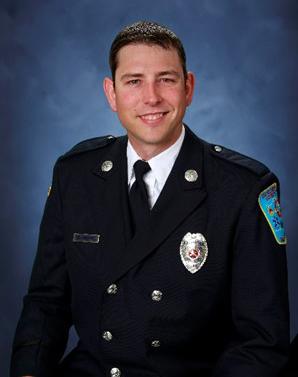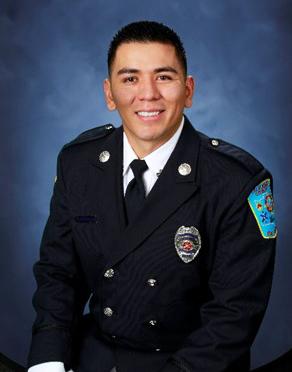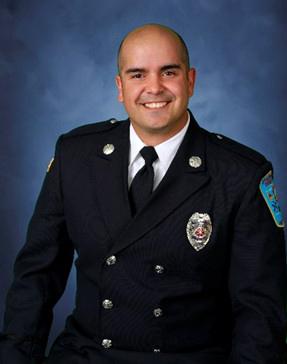 Courtesy/LAFD
Courtesy/LAFDA paramedic is a health care professional responsible for providing emergency medical assistance to patients in their homes and while transporting to a hospital. Paramedics are the first line medical personnel that treat everything from heart attacks to injuries from motor vehicle accidents.
LAFD paramedics respond to our community’s 911 calls. As the first healthcare providers at the scene of emergency situations, they collaborate with local emergency physicians and the police to evaluate critical situations. LAFD’s paramedics fill a multifaceted role, responding to much more than medical calls. They are also trained in hazardous materials response, technical rescue, firefighting, and community risk reduction.
Our three new paramedics join an incredible team of nearly 40 paramedics responding to the Los Alamos community. LAFD responds to nearly 2,200 calls per year, 80-90 percent of which are medical in nature.
LAFD paramedics are equipped with equipment like what is found in an emergency room. They provide direct patient care under a set of standing orders/protocols. Each ambulance carries a high-tech cardiac monitor that can read nearly every heart rhythm and has the capacity to transmit the monitor’s data to both the Los Alamos Medical Center and St. Vincent medical center where it is utilized to prepare the hospital to receive the patient and determine treatment options.
Each ambulance is a mobile Intensive Care Unit that carries a variety of medications utilized to treat a multitude of medical issues. These medications may be used to treat an asthma attack, diabetic emergency, cardiac arrhythmias, post-partum bleeding, overdoses, cardiac arrest and many more critical medical conditions.
The duties of a paramedic include:
- Help to resuscitate patients in an emergency before hospital admission.
- Provide medical assistance during emergency situations, such as CPR, AED, prevent shock, control severe bleeding, prevent spinal damage, etc.
- Administer intravenous medications, drips, and oxygen.
- Perform endotracheal intubations, maintaining an open airway.
- Evaluate a patient’s condition to determine the right course of treatment.
- Monitor a patient’s condition and keep it stable while enroute to the hospital.
- Aid in the transfer of patients to the emergency units of hospitals.
- Help to maintain a calm environment on the scene.
- Communicate with the patient and family members to explain what care is being provided and why.
- Create a patient care report and take notes of the medical treatment given to the patient which becomes a permanent part of the patient’s healthcare record.
- Keep the equipment clean after use; check and replace damaged and used supplies.
- Clean/decontaminate the interior of the ambulance after every call.
- Assist the public as needed.
Each year LAFD supports several students to attend paramedic school. The formal paramedic training is provided to qualified EMTs’ by the Santa Fe Community College. This higher learning institute specializes in providing training that meets the needs of the communities in Northern New Mexico while integrating industry best practices.
The paramedic program includes more than 1,000 hours of didactic education with a clinical and internship requirement that adds several hundred more hours of education. The program’s total length is approximately 14 months and prepares students to provide the highest level of prehospital care to every 911 caller.
The following is an overview of the paramedic course curriculum.
Paramedic Fundamentals Course
A paramedic is an emergency responder that provides care to patients while in transport to the hospital or another health facility. This course gives a basic overview of paramedic duties. Students will learn some of the first steps in providing emergency care, such as gathering patient history, assessing the situation and stabilizing the patient. A paramedic fundamentals course may be taken during different times in the program; first at the beginning as an introduction and later toward the middle or end of the program to discuss advanced techniques and procedures.
Pharmacology for Emergency Responders Course
Pharmacology is important for paramedics because the topic covers how medication may affect illness or injury and what doses are appropriate in various situations. In this course, students learn methods of medication administration that include intravenous dosing, injections, and inhaled treatments. Students may also learn how to asses a patient who may currently be taking medication and what emergency treatment options can be combined with such medications. Drug terminology, pulmonary diseases, and management of airways may also be covered.
Emergency Cardiovascular Management Course
The cardiovascular system has to do with a patient’s heart, blood, and circulatory system. Topics covered may include airway management, ventilation, cardiovascular disorders, and pathophysiology. Students will learn appropriate methods of care for cardiac emergencies, including management of cardiac arrest and monitoring 12 lead EKGs (electrocardiograms). Upon completing this course, students are certified in Advanced Cardiac Life Support or ACLS.
Trauma and Patient Management Course
In emergency situations, patients may be unresponsive, hostile or momentarily out of sorts. In this class, which is typically taken first at the primary level and then at a more advanced level, students study the treatment and care of patients relating to specific emergency situations. Topics may include uncontrolled bleeding, head injuries, abdominal injuries or trauma affecting multiple systems of the body. At the more advanced level, students will study procedures for dealing with patient burns, spinal injuries or orthopedic injuries.
Clinical Practicum Course
This course is the central requirement for paramedic certification. In a hands-on setting, students practice their paramedic skills under the supervision of a preceptor. Their ability to assess patients and manage stress in the pre-hospital environment is continually assessed by their supervisors.
 Matthew Austin
Matthew Austin
Matthew Austin was born and raised in Moriarty. He has been married to his lovely wife Kaitlyn for more than six years and they have a 2-year-old son, Riley. Austin graduated from Moriarty High School in 2007, then attended CNM; eventually settling on Fire Science for his major. This led to his testing with LAFD in April of 2011.
Austin started the LAFD Fire Academy in July of 2011. He has worked for LAFD for seven and a half years now.
“This career is flying by and will be over before I know it. That can’t be said about Paramedic School, however. It was a very challenging year that was full of growth, laughter, stress and exhaustion,” Austin said. “Kenny and Nate made it easier. We were able to rally around each other when the pressures of the (what seemed like endless) tests were bearing down.”
“Working as a team helped keep each other focused and solid throughout the program. It is an honor and a privilege to be a part of this great department,” he said. “I am thankful for the opportunities that are offered to us. These opportunities allow us to grow in our education and experience and help us better serve this community.”
 Kenny (Kenny) Martinez
Kenny (Kenny) Martinez
Kenny Martinez was born in Phoenix, Ariz. and raised in Espanola. He attended the University of New Mexico where he studied Exercise Science and became a personal trainer. While studying at the University of New Mexico, Martinez met a fire department candidate who was taking an EMT course who persuaded him to do the same. Martinez has been employed with the Los Alamos Fire Department for seven years and serves as an EMT for the Española Presbyterian Hospital as well.
“Looking back at the last 14 months of Paramedic School, I can’t help but feel grateful for the instruction and the clinical experience I’ve gained,” Martinez said. “I’m very fortunate that the Los Alamos Fire Department invested in me and my peers to further our education and bring back more advanced life support providers to the County of Los Alamos.”
 Nathaniel Sisneros
Nathaniel Sisneros
Nathaniel (Nate) Sisneros has worked at Los Alamos County Fire Department for seven years. He will be assigned to Station 1 C shift in the role of Paramedic/Hazmat Tech. Sisneros has a bachelor’s degree in Business Administration from Missouri Baptist University and is working toward an Associate Degree in Paramedicine from Santa Fe Community College. He is married with one son named Gabriel who will be the big one in February.
“Looking back at Paramedic school, I would say I am humbled to have had the opportunity to represent our department. Through the many ups and downs of school, I would never change my experience or my fellow LAFD members who helped me with a lot of my studies,” Sisneros said. “I am beyond grateful for Los Alamos County Fire Department to provide me with this opportunity and I am thankful to the many instructors who invested their time to provide us the knowledge and skills necessary for the field.”
“Your Hardest Times Often Lead to The Greatest Moments of Your Life.”

